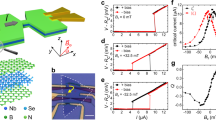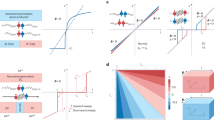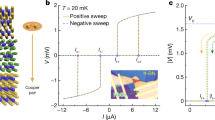Abstract
The diode effect is fundamental to electronic devices and is widely used in rectifiers and a.c.–d.c. converters. At low temperatures, however, conventional semiconductor diodes possess a high resistivity, which yields energy loss and heating during operation. The superconducting diode effect (SDE)1,2,3,4,5,6,7,8, which relies on broken inversion symmetry in a superconductor, may mitigate this obstacle: in one direction, a zero-resistance supercurrent can flow through the diode, but for the opposite direction of current flow, the device enters the normal state with ohmic resistance. The application of a magnetic field can induce SDE in Nb/V/Ta superlattices with a polar structure1,2, in superconducting devices with asymmetric patterning of pinning centres9 or in superconductor/ferromagnet hybrid devices with induced vortices10,11. The need for an external magnetic field limits their practical application. Recently, a field-free SDE was observed in a NbSe2/Nb3Br8/NbSe2 junction; it originates from asymmetric Josephson tunnelling that is induced by the Nb3Br8 barrier and the associated NbSe2/Nb3Br8 interfaces12. Here, we present another implementation of zero-field SDE using noncentrosymmetric [Nb/V/Co/V/Ta]20 multilayers. The magnetic layers provide the necessary symmetry breaking, and we can tune the SDE by adjusting the structural parameters, such as the constituent elements, film thickness, stacking order and number of repetitions. We control the polarity of the SDE through the magnetization direction of the ferromagnetic layers. Artificially stacked structures13,14,15,16,17,18, such as the one used in this work, are of particular interest as they are compatible with microfabrication techniques and can be integrated with devices such as Josephson junctions19,20,21,22. Energy-loss-free SDEs as presented in this work may therefore enable novel non-volatile memories and logic circuits with ultralow power consumption.
This is a preview of subscription content, access via your institution
Access options
Access Nature and 54 other Nature Portfolio journals
Get Nature+, our best-value online-access subscription
$29.99 / 30 days
cancel any time
Subscribe to this journal
Receive 12 print issues and online access
$259.00 per year
only $21.58 per issue
Buy this article
- Purchase on Springer Link
- Instant access to full article PDF
Prices may be subject to local taxes which are calculated during checkout




Similar content being viewed by others
Data availability
The data that support the findings of this study are available from the corresponding authors upon reasonable request.
References
Ando, F. et al. Observation of superconducting diode effect. Nature 584, 373–376 (2020).
Miyasaka, Y. et al. Observation of nonreciprocal superconducting critical field. Appl. Phys. Express 14, 073003 (2021).
Wakatsuki, R. et al. Nonreciprocal charge transport in noncentrosymmetric superconductors. Sci. Adv. 3, e1602390 (2017).
Yasuda, K. et al. Nonreciprocal charge transport at topological insulator/superconductor interface. Nat. Commun. 10, 2734 (2019).
Itahashi, Y. M. et al. Nonreciprocal transport in gate-induced polar superconductor SrTiO3. Sci. Adv. 6, eaay9120 (2020).
Daido, A., Ikeda, Y. & Yanase, Y. Intrinsic superconducting diode effect. Phys. Rev. Lett. 128, 037001 (2022).
Yuan, N. F. Q. & Fu, L. Supercurrent diode effect and finite momentum superconductors. Proc. Natl Acad. Sci. USA 119, e2119548119 (2022).
He, J. J., Tanaka, Y. & Nagaosa, N. A phenomenological theory of superconductor diodes. New J. Phys. 24, 053014 (2022).
Lyu, Y.-Y. et al. Superconducting diode effect via conformal-mapped nanoholes. Nat. Commun. 12, 2703 (2021).
Aladyshkin, A. Yu., Fritzsche, J. & Moshchalkov, V. V. Planar superconductor/ferromagnet hybrids: anisotropy of resistivity induced by magnetic templates. Appl. Phys. Lett. 94, 222503 (2009).
Aladyshkin, A. Yu. et al. Reverse-domain superconductivity in superconductor-ferromagnet hybrids: effect of a vortex-free channel on the symmetry of I-V characteristics. Appl. Phys. Lett. 97, 052501 (2010).
Wu, H. et al. The field-free Josephson diode in a van der Waals heterostructure. Nature 604, 653–656 (2022).
Zhu, Y., Pal, A., Blamire, M. G. & Barber, Z. H. Superconducting exchange coupling between ferromagnets. Nat. Mater. 16, 195–199 (2017).
Li, B. et al. Superconducting spin switch with infinite magnetoresistance induced by an internal exchange field. Phys. Rev. Lett. 110, 097001 (2013).
Baek, B., Rippard, W. H., Benz, S. P., Russek, S. E. & Dresselhaus, P. D. Hybrid superconducting-magnetic memory device using competing order parameters. Nat. Commun. 5, 3888 (2014).
Obi, Y., Ikebe, M., Wakou, H. & Fujimori, H. Superconducting transition temperature and dimensional crossover in Nb/Co and V/Co multilayers. J. Phys. Soc. Jpn 68, 2750–2754 (1991).
Monton, C., de la Cruz, F. & Guimpel, J. Magnetic behavior of superconductor/ferromagnet superlattices. Phys. Rev. B 75, 064508 (2007).
Banerjee, N. et al. Controlling the superconducting transition by spin-orbit coupling. Phys. Rev. B 97, 184521 (2018).
Misaki, K. & Nagaosa, N. Theory of the nonreciprocal Josephson effect. Phys. Rev. B 103, 245302 (2021).
Baumgartner, C. et al. A Josephson junction supercurrent diode. Nat. Nanotechnol. 17, 39–44 (2022).
Davydova, M., Prembabu, S. & Fu, L. Universal Josephson diode effect. Sci. Adv. 8, eabo0309 (2022).
Bauriedl, L. et al. Supercurrent diode effect and magnetochiral anisotropy in few-layer NbSe2. Preprint at arXiv https://doi.org/10.48550/arXiv.2110.15752 (2022).
Ando, F. et al. Fabrication of noncentrosymmetric Nb/V/Ta superlattice and its superconductivity. J. Magn. Soc. Jpn 43, 17–20 (2019).
Ando, F. et al. Investigation of the upper critical field in artificially engineered Nb/V/Ta superlattices. Jpn. J. Appl. Phys. 60, 060902 (2021).
Wakatsuki, R. & Nagaosa, N. Nonreciprocal current in noncentrosymmetric Rashba superconductors. Phys. Rev. Lett. 121, 026601 (2018).
Curran, P. J. et al. Continuously tunable critical current in superconductor-ferromagnet multilayers. Appl. Phys. Lett. 110, 262601 (2017).
Baur, E. et al. Heavy fermion superconductivity and magnetic order in noncentrosymmetric CePt3Si. Phys. Rev. Lett. 92, 027003 (2004).
Kaur, R. P., Agterberg, D. F. & Sigrist, M. Helical vortex phase in the noncentrosymmetric CePt3Si. Phys. Rev. Lett. 94, 137002 (2005).
Reyren, N. et al. Superconducting interfaces between insulating oxides. Science 317, 1196–1199 (2007).
Naritsuka, M. et al. Extremely strong-coupling superconductivity in artificial two-dimensional Kondo lattices. Phys. Rev. B 96, 174512 (2017).
Blaha, P. et al. WIEN2k: an Augmented Plane Wave Plus Local Orbitals Program for Calculating Crystal Properties (Techn. Universität, 2018).
Blaha, P. et al. WIEN2k: an APW+lo program for calculating the properties of solids. J. Chem. Phys. 152, 074101 (2020).
Acknowledgements
This work was partly supported by Japan Society for the Promotion of Science KAKENHI (grant nos 15H05702, 15H05884, 15H05745, 18H04225, 18H01178, 18H05227, 19H05823, 20H05665, 21K13883 and 21K18145); the Cooperative Research Project Program of the Research Institute of Electrical Communication, Tohoku University; and the Collaborative Research Program of the Institute for Chemical Research, Kyoto University. This study was also supported by the Futaba Foundation’s Futaba Research Grant Program, and Iketani Science and Technology Foundation. A.V.O., A.S.S. and T.O. acknowledge the Russian Ministry of Science and Higher Education for state support of scientific research conducted under the supervision of leading scientists in Russian institutions of higher education, scientific foundations and state research centres (project no. 075-15-2021-607).
Author information
Authors and Affiliations
Contributions
H.N. and T.O. conceived the project. H.N. deposited the multilayers and fabricated the devices. H.N. performed the measurements and data analysis. H.N. and T.O. wrote the manuscript with the assistance of the other authors. J.I. and Y.Y. calculated the band structure and assisted with the analysis of the experimental results. All authors contributed jointly to the interpretation of the results.
Corresponding authors
Ethics declarations
Competing interests
The authors declare no competing interests.
Peer review
Peer review information
Nature Nanotechnology thanks the anonymous reviewers for their contribution to the peer review of this work.
Additional information
Publisher’s note Springer Nature remains neutral with regard to jurisdictional claims in published maps and institutional affiliations.
Supplementary information
Supplementary Information
Supplementary Figs. 1–7 and Discussion.
Rights and permissions
About this article
Cite this article
Narita, H., Ishizuka, J., Kawarazaki, R. et al. Field-free superconducting diode effect in noncentrosymmetric superconductor/ferromagnet multilayers. Nat. Nanotechnol. 17, 823–828 (2022). https://doi.org/10.1038/s41565-022-01159-4
Received:
Accepted:
Published:
Issue Date:
DOI: https://doi.org/10.1038/s41565-022-01159-4
This article is cited by
-
High-temperature Josephson diode
Nature Materials (2024)
-
Superconducting tunnel junctions with layered superconductors
Quantum Frontiers (2024)
-
Diode effect in Josephson junctions with a single magnetic atom
Nature (2023)
-
Local control of superconductivity in a NbSe2/CrSBr van der Waals heterostructure
Nature Communications (2023)
-
Evolution of superconducting diodes
Nature Physics (2023)



